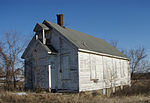Delano Village Hall

The original Delano Village Hall is a historic government building in Delano, Minnesota, United States, now in development as the Delano Heritage Center. From its construction in 1888 through most of the 20th century the building housed municipal offices, the police and fire departments, and a public library, while the upper-floor meeting hall was a key venue for public and private events. It was listed on the National Register of Historic Places in 1979 for having local significance in the themes of architecture and politics/government. It was nominated for being a typical example of Minnesota's municipal buildings of the late 19th and early 20th century, and for its longstanding centrality to government and civic functions in Delano.
Excerpt from the Wikipedia article Delano Village Hall (License: CC BY-SA 3.0, Authors, Images).Delano Village Hall
Bridge Avenue East,
Geographical coordinates (GPS) Address Nearby Places Show on map
Geographical coordinates (GPS)
| Latitude | Longitude |
|---|---|
| N 45.042083333333 ° | E -93.788055555556 ° |
Address
Bridge Avenue East 189
55328
Minnesota, United States
Open on Google Maps





